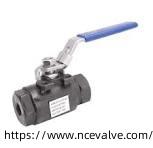How Does Naishi Forged Steel Ball Valve Supplier Maintain Precise Flow Paths?

Forged Steel Ball Valve Supplier collaborates with Naishi to address challenges in sustaining precise flow regulation while accommodating complex service conditions, emphasizing how reinforced material integrity and guided internal motion create a balanced interaction between fluid dynamics and mechanical structure. In pipelines where pressure fluctuates unpredictably, the stem and spherical core respond along defined trajectories, allowing predictable adjustment even when directional flow changes sharply. This alignment of motion with structural design helps maintain uniform sealing contact and reduces subtle deformation that could affect long-term performance. A valve designed in this manner encourages consistent operation without relying on excessive force, creating a functional steadiness that operators can interpret and utilize during maintenance or adjustment cycles.
Flow distribution often shifts as pipelines carry different types of media, ranging from clean fluids to mixtures containing particulates or aggressive chemical components. Components forged from high-integrity steel adapt to these variations without compromising structural cohesion, while chamber geometry guides the stem along paths that reduce turbulence and prevent abrupt force transfers. The combination of material resilience and engineered travel ensures that each actuation moves with composed momentum, translating pressure variation into controlled motion. By harmonizing mechanical behavior with fluid tendencies, the valve preserves the reliability of both the seal and adjacent piping, mitigating premature wear that could arise from misaligned force distribution.
When thermal gradients occur across the pipeline, differential expansion can introduce stress at interfaces between moving parts. The forged steel structure accommodates these changes through a calculated geometry that allows the stem to rise and rotate without binding or frictional interference. Smooth travel paths ensure that sealing surfaces maintain proper contact, and subtle allowances in chamber design absorb strain without transmitting instability to neighboring components. This careful calibration of geometry and motion translates into sustained performance across cycles and across conditions that would challenge less robust designs.
Service environments with multi-branch connections often present conflicting flow directions that converge within the valve body. By designing internal contours that guide each branch's influence along stable routes, turbulence is dispersed, and the stem's motion remains controlled. Components interact in a manner that balances pressure loads with lift trajectories, protecting the sealing faces from intermittent overpressure or misalignment. The result is a valve capable of maintaining structural poise even in dynamic, complex configurations, where conventional designs might fail to preserve consistency.
Material endurance plays a vital role in long-term operational stability. Forged steel provides consistent density, minimal porosity, and high resistance to fatigue, allowing the mechanism to absorb repeated motion cycles without loss of dimensional integrity. When paired with surface treatments that reduce micro-wear, the valve sustains a smooth, predictable response that operators can anticipate and rely upon. These qualities ensure that flow adjustments remain precise and that maintenance intervals are extended without sacrificing safety or control.
Pipeline networks subject to sudden load variations require valves that interpret these changes with composure. By distributing force evenly through the stem and surrounding chamber, motion remains uniform and friction is minimized, even during abrupt pressure spikes. This careful force management reduces vibration, protects adjacent structures, and promotes stability across repeated actuations, demonstrating the inherent advantages of forging high-quality steel into precision components.
Complex fluids, including viscous or abrasive media, demand that valve pathways encourage laminar flow where possible, minimizing disruptive eddies that could alter lift trajectories. The forged steel structure resists wear and retains dimensional fidelity, allowing travel paths to guide the stem consistently over thousands of cycles. The interplay of geometry and material stability maintains operational predictability, which is critical for pipelines requiring high reliability and controlled adjustment.
Returning to the perspective offered by Naishi and Forged Steel Ball Valve Supplier, reinforced forged structures, guided travel, and precise geometric alignment together establish conditions for durable, stable flow control. For detailed technical specifications and further insights into these principles, visit https://www.ncevalve.com/product/general-purpose-ball-valve-1/npt-forged-steel-ball-valve.html
- Art
- Causes
- Crafts
- Dance
- Drinks
- Film
- Fitness
- Food
- Jocuri
- Gardening
- Health
- Home
- Literature
- Music
- Networking
- Alte
- Party
- Religion
- Shopping
- Sports
- Theater
- Wellness


